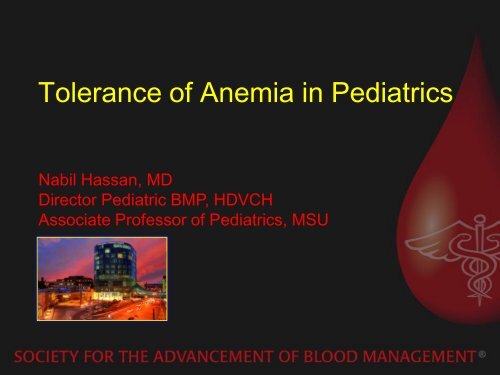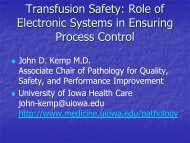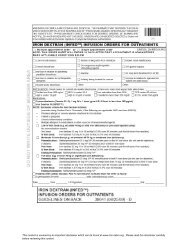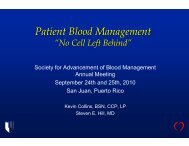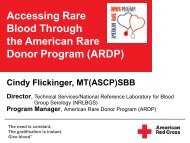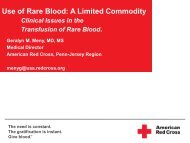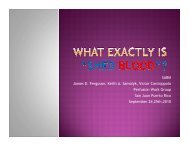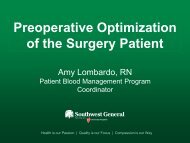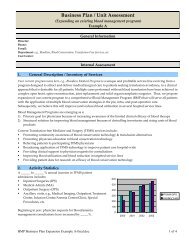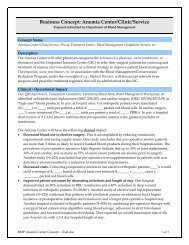Tolerance of Anemia in Pediatrics - SABM - Patient Blood ...
Tolerance of Anemia in Pediatrics - SABM - Patient Blood ...
Tolerance of Anemia in Pediatrics - SABM - Patient Blood ...
You also want an ePaper? Increase the reach of your titles
YUMPU automatically turns print PDFs into web optimized ePapers that Google loves.
<strong>Tolerance</strong> <strong>of</strong> <strong>Anemia</strong> <strong>in</strong> <strong>Pediatrics</strong>Nabil Hassan, MDDirector Pediatric BMP, HDVCHAssociate Pr<strong>of</strong>essor <strong>of</strong> <strong>Pediatrics</strong>, MSU
Disclosures• I could only wish for…• Employed <strong>in</strong>tensivist• <strong>SABM</strong> board member
<strong>Anemia</strong>:How Low Can We Go?• Healthy conscious adultvolunteers (n=21)Healthy patients prior to surgery(n=11)• <strong>Blood</strong> aliquots removed to reduceHb (13 5 gm/dl)• No evidence <strong>of</strong> critical DO 2• Weiskopf, RB JAMA279;217:1998
<strong>Blood</strong> Transfusions <strong>in</strong> Pediatric<strong>Patient</strong>s• Pediatric health <strong>in</strong>formation system data (2001-2003), part <strong>of</strong> ChildHealth Corporation <strong>of</strong> America:• 35 academic centers:• 4.14% transfused• 87% <strong>of</strong> all transfusions• 1.1% severe complications• Asian, <strong>in</strong>creased severity, neutropenia, and sickle cellAnthony Slonim et al., Transfusion (2008) Vol 48: 73-80.
Number <strong>of</strong> units2011 PRBC Utilization atHDVCH (January-April)302520151024.5 24.5 25.2 25.222.920.319.52.536NICUPICUHem/OncOutpatient502005 2006 2007 2008 2009 201019%Hem/OncInpatientOthers23•Prorated yearly utilization <strong>of</strong> 2,265 units(10% <strong>of</strong> system total) = $1.7million• 1.65 million units nationally = $ 1.25 billion
<strong>Anemia</strong> <strong>in</strong> <strong>Pediatrics</strong>Age Hb (g%) Anemic>32 wk 15.0 14Term* (cord) 16.5 13.51-3 dy 18.5 14.52 wk 16.6 13.41 mo 13.9 10.72 mo 11.2 9.46 mo-2 yr 12.0 10.52-6 yr 12.5 11.56-12 yr 13.5 11.512-18 yrMaleFemale14.514.01312201816141210Hgb864202 4 6 8 10 12 14Postnatal WeeksTermPreterm*
Is it only Hb?VO2• Shock• Burns• Trauma• growth• High SADO2• Hb level &Type <strong>of</strong> Hb• Cardiac output( HR, SV)• Oxygenation
Compensation for <strong>Anemia</strong>1. CO (HR & Strokevolume)2. Tachypnea (apnea)3. Regional Autoregulation(NEC)4. Viscosity ( flow)5. Extraction
Developmental Changes <strong>in</strong> Hb
Pediatric <strong>Patient</strong>s Subgroups• Neonates• General floor• Burn• Cardiac• PICU• sepsis
Love all, Serve allHurt never, Serve everSathya Sai-Baba“First do no harm”
Transfusion Management Strategies: A Survey <strong>of</strong>Practic<strong>in</strong>g Pediatric Hematology/OncologySpecialists• A web based survey <strong>of</strong> ASPH/O members• 86% felt EPO not <strong>in</strong>dicatedEd Wong. Pediatric <strong>Blood</strong> Cancer 2005; Vol. 44: 119-127.
Neonatal: <strong>Anemia</strong> howbad/Transfusions How Good• Physiologic markers: HR, RR, As & Bs, poor weight ga<strong>in</strong>• Higher Hct reduced Apnea & periodic breath<strong>in</strong>g Joshi A 87• HB, SVO 2 and lactate weakly correlate to markersBifano 92• Volume was as effective. Bifano 93• Transfusions improve wt. ga<strong>in</strong> Meyer J. 93.• Transfusions do not improve wt. ga<strong>in</strong> Chen H. 09
Neonatal <strong>Anemia</strong>• Convalesc<strong>in</strong>g <strong>in</strong>fants (< 32W) with Hb
Effect <strong>of</strong> Transfusion <strong>in</strong> ELBW• U <strong>of</strong> W (Seattle), 2006,60 ELBW• Transfused 78% (47/52)• No benefit (weight ga<strong>in</strong>,apnea, vent. days)• No effect on sepsis• Higher ROP grade• Higher NECValieva O, et al, (Sept 2009) J Peds Vol 155, No. 3: 331-37.
Association <strong>of</strong> NEC with <strong>Anemia</strong> andTransfusion <strong>in</strong> Preterm Infants (< 32 weeks)• S<strong>in</strong>gle Center,Retrospective: 111 NEC,222 Control(2000-2008)• <strong>Anemia</strong>: ↑ O.R. 1.1(P. 01)• RBC: ↑ O.R.• 24 hours: 7.60 .001• 48 hours: 5.55 .001• 96 hours: 2.13 .07R. S<strong>in</strong>gh et al. Journal <strong>of</strong> Per<strong>in</strong>atology (January 2011) Vol. 31, 176-182.
Liberal vs Restrictive Transfusions(Iowa Trial)• 100 neonates randomized• 950 gm, 28 wks (mean)• Liberal gp received EPO & PRBCLiberal RestrictiveVentilated Hct < 46 < 34%CPAP Hct < 38 < 28Room Air < 30 < 22Bell Pediatric 2005; 115: 1685-91
Liberal vs. Restrictive RBC‟sTransfusions (Iowa Trial)Liberal Restrictive PTransfusions 5.2 3.3 .025DonorExposure2.8 2.2 .08IVH G IV 0 4 .054PVL 0 4 .115Either or Both 0 6 .012Apneas > 20seconds32 52 .004No early and no late ultrasound <strong>in</strong> 50% Bell ,Pediatric 2005; 115: 1685-91
Kirpalani: (PINT) Trial (2006)• 451 ELBW, 770gm, high vs low threshold• No difference <strong>in</strong> death, ROP, BPD, bra<strong>in</strong> <strong>in</strong>jury• Low Hb gp (89% transfused, 3.7 donors)High Hb gp (95% transfused, 4.2 donors)• Number <strong>of</strong> transfusions (4.9 vs. 5.7 ,P0.07)Mean eventual Hb difference (1.1 gm)No difference <strong>in</strong> NDI at 18-22 m (low 45%, high 39%)Whyte Kirpalani <strong>Pediatrics</strong> (2006) 123 (1): 207-13
Neurodevelopmental Outcome <strong>of</strong> Extremely LowBirthweight Infants Randomly Assigned to Restrictive orLiberal Hemoglob<strong>in</strong> Thresholds for <strong>Blood</strong> TransfusionsOR (95% CI)PDeath 1.18 (0.72-1.93) 0.52Cerebral palsy 1.32 (0.53-3.27) 0.07Cognitive delay, Bailey MDI
Long-term Outcome <strong>of</strong> the IowaTrial•MRI studies <strong>of</strong> 44 <strong>of</strong> the orig<strong>in</strong>al 100 and 40 FT controls•Girls more affected <strong>in</strong> the liberal sp.I.C. VolumeLiberal n=26 Restricted n=18nCortex Volume n nWhite Matter VolumeB.G. VolumeNopoulos, Conrad, Bell, Strauss, Widness et al. Arch Pediatric Adolescent Medic<strong>in</strong>e. May 2011; 165(5): 443-50.
summarycompensation• Increased CO• Increased flow• Increased RRdecompensation• Lethargy• Poor feed<strong>in</strong>g• Apnea, PB• Bradycardia• Lactic acidosis• PVL / IVH• NEC
Survey <strong>of</strong> Canadian NeonatalTransfusion Practices (1990)Heather Hume, Ronald Strauss, G. Levy (1997). Transfusion Science Vol. 18 (No. 1), pp 71-80.• Pediatric Hemotherapy Committee <strong>of</strong> AABB• Transfusion Triggers (variable):1. Removal <strong>of</strong> 10% <strong>of</strong> TBV2. Specific Hematrocrit3. Signs <strong>of</strong> <strong>Anemia</strong>4. OthersBoth transfusion and anemia are bad
Beyond the Neonate• Transfusion <strong>of</strong> (9) pediatric ICUpatients with• septic shock: DO 2 but notVO 2M<strong>in</strong>k. CCM.1990.• Transfusion <strong>of</strong> H/O (17)outpatients: VO 2 (19%)Grant M (Utah). PCCM. Vol. 4, No. 4,2003:450-64.• Background pathology• Ability to compensate
PercentEffect <strong>of</strong> <strong>Blood</strong> Transfusion on Survival AmongChildren <strong>in</strong> a Kenyan Hospital• 2433 pediatric admissions (1989-1990)• 29% had Hb< 5 gm% (20%transfused), median age 10months• Hb< 5, MR 18%, > 5 MR 8% (p.001) (66% with<strong>in</strong> 48 hrs.)9080706050403020100Transfused• Hb< 4.7 + RD, Transfusiondecreased MR (OR 0.9)• Hb< 3.9 gm%. Transfusion with<strong>in</strong>48 hrs, Decreased MR (OR 0.37)Hemoglob<strong>in</strong> (g/dl)Fig 1- Transfusion <strong>of</strong> children accord<strong>in</strong>g to admission Hb.Eve M. Lackritz et al. The Lancet, Vol. 340. August 29, 1992.
Longitud<strong>in</strong>al Evaluation <strong>of</strong> Severely AnemicChildren <strong>in</strong> Kenya• 1991, 6 moth duration,admission – 8 week follow-up• 25% (n=303) Hb < 5,MR 16 % while <strong>in</strong>-hospitalMR 30% overall63% with respiratorydistress• 72% transfusedWithout RDWith RDEve M. Lackritz et al. AIDS, Vol. 11, No. 12: June 1997: pp 1487-1494.
<strong>Blood</strong> Transfusion for Severe <strong>Anemia</strong> <strong>in</strong>Children <strong>in</strong> a Kenyan Hospital• Retro (‟98-99) and Pro (‟99-00)• 15% <strong>of</strong> admission had Hb < 5 gm%• MR 8% regardless <strong>of</strong> transfusions (65%)• Respiratory Distress MR odds 5.3, Tr 4.1• Prostration MR odds 22.8, Tr 5Mike English et al. The Lancet, Vol 359, February 9, 2002.
Effects <strong>of</strong> a Restrictive <strong>Blood</strong> TransfusionPolicy on Outcomes <strong>in</strong> Children with BurnInjuryHb >10 (n= 146) Hb > 7 (n= 127)Transfusions* 12.3 ± (1.8) 7.2 ± (1.2)Vent Days 13.2 ± (2.3) 8.4 ± (1.5)Complications** 1.03 0.9*P .001**P .05LOS 4.8 ± (4) 3.9 ± (3)MR 8.2% 5.7%•Retrospective, sequential (2000 2002 2005)•Similar Total Body Surface Area (TBSA), degrees, <strong>in</strong>halation<strong>in</strong>jury, and # operationsT<strong>in</strong>a L. Palmieri et al. Journal <strong>of</strong> Burn Care and Research, January/February 2007.
The Pediatric Heartache• Myocarditis,cardiomyopathy,arrhythmia, anomalouscoronary• TOF,TGA• VSD,TAPVR,CTT• CoA• S<strong>in</strong>gle ventricleContractilityrhythmPulmonarycongestionHeartfailureCyanosisObstruction
Red <strong>Blood</strong> Cell Transfusion for Infants withS<strong>in</strong>gle Ventricle Physiology• < 1 yr., no 72˚ post-op ,no active bleed<strong>in</strong>g••n= 59, transfusion= 183•Best at 12 hoursHBDiastolicBPO2SaturationNIRS7.8-12.3 + + +12.4-13.2 + + -13.3-15.7 + - -James Kno et al., Pediatric Cardiology (2011) vol. 32: 461-468.
RCT <strong>of</strong> high vs low HB <strong>in</strong> post-op s<strong>in</strong>gleventricle cavopulmonary connection• n 60, >13 vs
<strong>Anemia</strong>, <strong>Blood</strong> Loss & Transfusions <strong>in</strong>North American PICU (PALISI)• Observational study, 6 m, 30 PICUs (2004-2005)• N = 977, > 48° PICU stay• <strong>Anemia</strong> (74%): 33% on admission, 41% after admission(more <strong>in</strong> neonates & adolescents)• Phlebotomy: 8.25 ml/day (.32 ml/kg/day)(73% <strong>of</strong> blood loss)• Transfused: 49% (74% with<strong>in</strong> 48°)• Trigger (anemia <strong>in</strong> 42%), Hb 9.7 + 2.7Scot Bateman, et al(2008), Am J. Respir Crit Care Med, Vol 178, P 26-33.
Pretransfusion Hb and LOS98.37.9Hassan, Sanfilippo,Rajasekaran, <strong>SABM</strong>, 2010
TRIPICU Study•19 PICUs, n=648, 4 different countries•3 days to 14 years <strong>of</strong> age•Hb <strong>of</strong> < 9.5 g/dl <strong>in</strong> first 7 days <strong>of</strong> PICU admit•Hemodynamically stable•Transfusion at
Subgroup Report<strong>in</strong>gPost Surgical*Post Cardiac Surgery**R (60) L (64) R (63) L (62)PRISM 3.5 4.4 3.4 3.2MODS 35% 29% 46% 44%New or 8% 9% 12.7% 6.5%ProgressiveMODSMV Days 7.7 d 7.4 d 62% 60%PICU Stay 7.7 7.9 (p 03) 7 528 Day MR 2% 2% 3.2% 3.2%Hb Start 7.7 7.9 8.3 8Hb Differenceat 28d2.3 gm 2.1 gm*Just<strong>in</strong>e Rouette. Annals <strong>of</strong> Surgery, Vol. 251, No. 3, March 2010: pp 421-4**Ariane Willems. Critical Care Medic<strong>in</strong>e 2010, Vol. 38, No. 2: pp 649-656.
<strong>Anemia</strong> and Sepsis• Keep Hb > 10 gm/dL> 12gm <strong>in</strong> neonatees(Level II evidence)J. Brierley. “2007 Update from the American College <strong>of</strong> Critical CareMedic<strong>in</strong>e.” Critical Care Medic<strong>in</strong>e 2009, Vol 37, No 2: pp 666-88.• Keep Hb > 7 gm/dL“Surviv<strong>in</strong>g the Sepsis Campaign.” Phil Dell<strong>in</strong>ger (ACCP, ATS, AACCN, etc.),Critical Care Medic<strong>in</strong>e 2004, Vol 32, No 3: 856-873.
RBC Transfusion Thresholds <strong>in</strong>Pediatric <strong>Patient</strong>s with SepsisStable sepsis patients (TRIPICU):– Restrictive group (R) < 7 g% (n=69)– Liberal group (L) < 9.5 g% (n=68)– MOD (R=18.8%, L=19.1%)– LOS (p=0.74)– MR (p=0.44)Karam O., Tucci M., Canadian Critical Care Trial Group, 31 st International Symposium on Intensive Care and EmergencyMedic<strong>in</strong>e, March 2011: Brussels, Belgium.
Take Home Message•ANEMIA has a potential harm (NEC,CNS,MORTALITY).•Threshold could be lower than 7 gm <strong>in</strong> stablepatients(PICU,BURN,NICU,SEPTIC) but more than 5grams•Hb <strong>of</strong> 11 is adequate <strong>in</strong> post op. cyanotic•No good data on acute shock, <strong>in</strong>crease ICP,ARDS,trauma,hyperthermia
Neonatal <strong>Anemia</strong>• Physiologic• Early <strong>Anemia</strong> <strong>of</strong> Prematurity– Acute Illness– <strong>Blood</strong> losses• Late <strong>Anemia</strong> <strong>of</strong> Prematurity– Low Erythropoiet<strong>in</strong>– Rapid growth– Chronic Illness• Other <strong>Anemia</strong>s– Hematological Disorders201816141210Hgb8642– Surgical <strong>Anemia</strong> 02 4 6 8 10 12 14Postnatal WeeksTermPreterm


